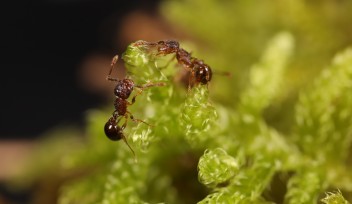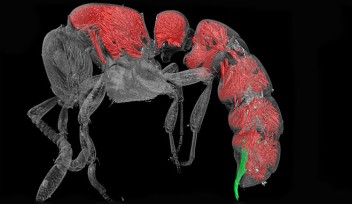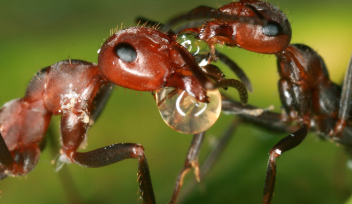Ants perform emergency medical care in the field

Saving lives through surgery is no longer exclusive to humans. In a recently published study in the journal Current Biology, researchers detail how Florida carpenter ants, a common, brown species native to USA, assess and selectively treat the wounded limbs of fellow nestmates by wound cleaning or amputation. Not only did the treatment aid in recovery, but the research team from the University of Würzburg, University of Lausanne and the Okinawa Institute of Science and Technology (OIST) found the ants’ choice of care catered to the type of injury presented to them.
“When we're talking about amputation behavior, this is literally the only case in which a sophisticated and systematic amputation of an individual by another member of its species occurs in the animal kingdom,” says first author Dr. Erik Frank, a behavioral ecologist from the University of Würzburg.
Hands-on care
Wound care among ants is not an entirely new phenomenon. In a 2023 study by the research team, which includes Prof. Evan Economo from the Biodiversity and Biocomplexity Unit at OIST, discovered that a different group of ants, Megaponera analis, use a special gland to inoculate injuries with antimicrobial compounds to quell possible infections. What makes Florida carpenter ants (Camponotus floridanus) stand out is that because they have no such gland, they appear to be using only mechanical means to treat their nestmates.
The researchers found that this mechanical care involves one of two routes. The ants would either perform wound cleaning with just their mouthparts or perform a cleaning followed by the full amputation of the leg. To select which route they take, the ants appear to assess the type of injury to make informed adjustments on how best to treat the patient.
In this study, two types of leg injuries were analyzed, lacerations on the femur and those on the ankle-like tibia. All femur injuries were accompanied by initial cleaning of the cut by a nestmate, followed by a nestmate chewing off the leg entirely. In contrast, tibia injuries only received the mouth cleaning. In both cases, intervention resulted in ants with experimentally infected wounds having a much greater survival rate.
“Femur injuries, where they always amputated the leg, had a success rate around 90% or 95%. And for the tibia, where they did not amputate, it still achieved about the survival rate of 75%,” says Dr. Frank. This contrasts with the less than 40% and 15% survival rate for unattended infected femur and tibia abrasions, respectively.
Thorough diagnostics
The researchers hypothesized that the preferred path of wound care could be related to the risk of infection from the wound site. To investigate this, the researchers collaborated with Prof. Economo and his unit at OIST, who are experts in 3D imaging and ant anatomy. OIST graduate student Lazzat Aibekova captured and analyzed images of the structure of different segments of the ant legs, to relate that to blood flow and wound healing. She found the femur is largely composed of muscle tissue, suggesting it plays a functional role of pumping blood, referred to as hemolymph, from the leg into the main body. With an injury to the femur, the muscles become compromised, reducing their ability to circulate potentially bacteria-laden blood. The tibia, on the other hand, has little muscle tissue and thus little involvement in blood circulation.
“In injuries to the tibia, the flow of the hemolymph was less impeded, meaning bacteria could enter the body faster, while in injuries to the femur, the speed of the blood circulation in the leg was slowed down,” says Dr. Frank.
One would think that if tibia damage results in faster infections, amputating the full leg would be most appropriate. However, the researchers found that the speed at which the ants can amputate a leg makes a difference. An ant-assisted amputation takes at least 40 minutes to complete. Experimental testing demonstrated that with tibia injuries, if the leg was not immediately removed post-infection, the ant would not survive. “Thus, because they are unable to cut the leg sufficiently quickly to prevent the spread of harmful bacteria, ants try to limit the probability of lethal infection by spending more time cleaning the tibia wound,” remarks senior author and evolutionary biologist Dr. Laurent Keller of the University of Lausanne. Dr. Frank adds that “the fact that the ants are able to diagnose a wound, see if it's infected or sterile, and treat it accordingly over long periods of time by other individuals—the only medical system that can rival that would be the human one.”
Considering the sophisticated nature of these behaviors, a reasonable next thought would be how these ants are capable of such precise care. “It’s really all innate behavior,” says Dr. Keller. “Ant behaviors change based on the age of an individual, but there is very little evidence of any learning.”
This study deepens the parallels between ant and human medicine; amputation was once a preferred treatment for infected limbs, but it was ultimately replaced by targeted application of antibiotics. The studies show that different ant species also use these strategies to cope with their battlefield injuries.
Prof. Economo concludes, “This illustrates again that animals living in societies have evolved complex cooperative behaviors, in this case medical care, that we naively thought were uniquely human.”
---
This press release was adapted from the original published by Cell Press, edited by Adrian Skov.
Article Information
Research Unit
For press enquiries:
Press Inquiry Form













